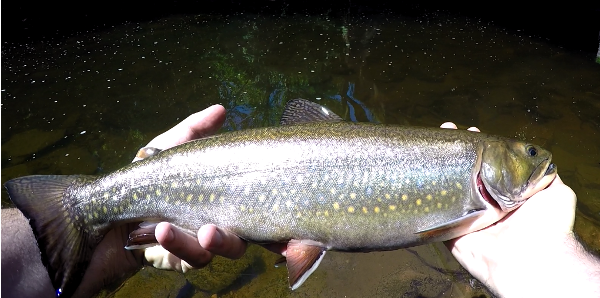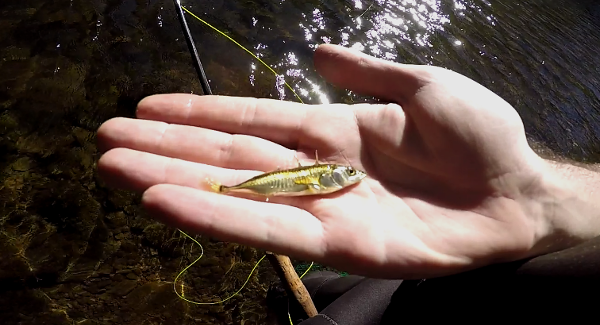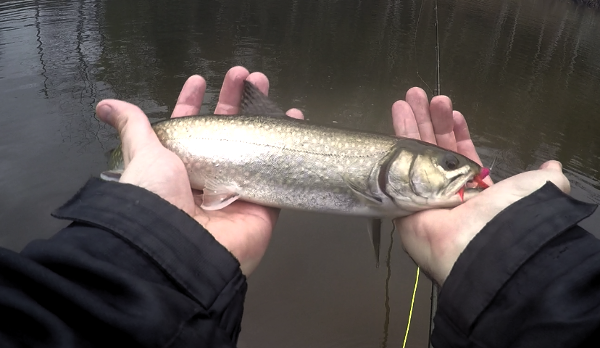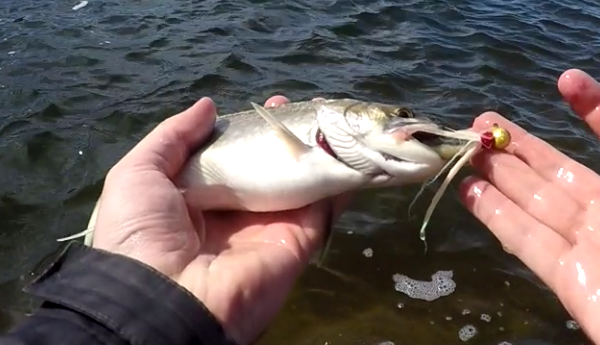I’m lucky enough to live in an area that brook trout (Salvelinus fontinalis) are still king. They can be found in every river in the province of Prince Edward island. The majority of the rivers here support a healthy sea run brook trout population. While there are resident brook trout that stay in the streams all year long, the larger and highly sought after sea run brook trout (also known as speckled trout, sea trout, coasters around the great lakes, or salters locally) move between salt and fresh water throughout the year. These are the real trophy brook trout anglers are after.
This post uses amazon affiliate links. I receive commission from any sales at no additional cost to yourself.

Every year I get asked questions like “Where do I find sea run brook trout?” or “what time of year do sea run brook trout move up river?” by either new anglers, or more experienced anglers that are just new to the area. The answer varies a bit yearly based on factors like weather, snow melt, etc, but the sea trout movements are fairly predictable. Sea run brook trout follow similar movement patterns to within a few weeks of being accurate year to year, you just need to know what factors influence their movement.
I’ve spent a non-trivial amount of time scouring the internet for research into the movements of sea run brookies. While there is useful information out there, it’s little and far in between. I hope my own personal experience angling for these monster brook trout helps other anglers track them down in their own area (or even here on PEI, although I won’t be sharing any specific fishing holes!). I know Newfoundland, Nova Scotia, New Brunswick, Maine, Norther Quebec, Northern Ontario, and Northern Manitoba are all home to some huge trophy brook trout.
To understand the movement patterns of any animal you have to first understand what motivates them. Trout are fairly simple creatures and their motivators are pretty basic, as far as I can tell there are four key factors that contribute to brook trout movement from salt water to fresh water.
- Food Availability
- Spawning
- Water Temperature
- Safety (Specifically, avoiding predators)
Understanding how these factors change throughout the seasons can help to pinpoint where to fish for trout at any given time of the year, day, or tide.
Food Availability
There is a never ending quantity of prey for trout in our estuaries all year round. Sand shrimp, mummichogs, and sticklebacks provide a bountiful source of prey for trout, with many invertebrates and other juvenile species of fish becoming available at different times of the year.

On the opening day of fishing season (April. 15th as of writing this. Check the regulations, they can change.) you will only find smaller resident brook trout further up stream, all the large sea run brookies are in the estuaries at this time. The sea run brook trout will only start running up rivers sometime between the end of the smelt run (starts in April, ends in May) and the beginning of the Gaspereau run (June). You can often see large trout moving just ahead or just behind the Gaspereau school, although all but the largest brook trout tend to get bullied (which results in very poor fishing) when the Gaspereau are spawning.
Smelt and Gaspereau eggs are both quite sticky and small. These eggs are very numerous, so do provide a short term source of food for brook trout. The eggs are not in the water column long enough to be a long-term source of food though. What the trout do take advantage of is the large amount of fry that hatch from these eggs. I’m unsure how long the smelt fry stay in the river, but the majority of Gaspereau fry will stay in the river until July or August. This provides a significant amount of forage for trout in the rivers for most of the summer. They eagerly chase down these prey items. Unsurprisingly, streamer patterns and small swimbaits work very well during this time of year (honestly, they work well all year).
While there are some early brook trout runs in May, it’s usually well into June before the majority of sea run brook trout have migrated up the rivers. At this time mayfly hatches are in full force, with some impressive stonefly hatches and significant caddisfly hatches happening a bit later in the season. This coupled with an ever present population of nymphs, terrestrial insects, small fish, and various other forage items provide sea run brook trout all the food they need throughout the warmer months of the year in the rivers. As it cools down in the fall there is less active forage available in the rivers for trout, so the trout turn once again to the sea. The brook trout need to do one more thing before returning to sea in the fall though…
Spawning
Like Atlantic Salmon, brook trout spawn in the fall. Throughout the summer, brook trout move up and down the river driven by factors outlined elsewhere in this post. The large brook trout will move very far up river to spawn around mid to late August, and you will not find them throughout the middle to lower stretches of the river any more during this time.
The angling season for brook trout ends September. 15th (as of writing this, again… check the regulations) to allow them to breed in peace. Since fishing seasons close for brookies at this time, I’m not sure what their movements are immediately after spawning. I can say that I catch very few sea run brookies in the salt between September. 15th and Novemer. 15th when I’m fishing for steelhead. Nearing the end of Steelhead season (Nov. 15th… check the regulations) I start to catch a few long, but thin brookies. For any Atlantic salmon anglers reading this, they’re almost like a slink Atlantic Salmon at this point. I assume these are the first few brook trout making their way back to the salt after breeding. The rest of the brook trout must make their way back to the estuaries at some point over the winter because that’s where the sea run brookies are in spring. I assume they over winter in salt water.

Water Temperature
Brook trout are cold water fish, and the cold never seems to bother them much. What does bother them is the heat of summer. Brook trout become lethargic as the water temperature rises, and the oxygen content of the water drops.
The rivers here on PEI are spring feed and remain relatively cool throughout the summer, especially in the upper reaches of the river. I suspect this has much to do with why all the largest brook trout seem to be in the rivers by the time the dog days of summer arrive.
As the water temperature warms up in summer, mouths of tributaries, the end of riffles, and bottom of pools all provide holding areas that are well oxygenated with cool water temperatures for brook trout to hold in. The larger the brook trout, the more sensitive they are to low oxygen levels. This also means larger fish are more likely to be holding in these cooler, more highly oxygenated sections of river.
In the spring, excessive snow melt can delay the runs of smelt, gaspereau, and by extension sea run brookies. Water temp may play a role in the delay, or it could be the excessively strong current preventing the fish from swimming up river until things calm down. Whatever the reason, years with a large amount of snow melt typically have sea run brookies entering rivers a few weeks later than years with relatively little snow melt.
Canadian readers, click here for Canadian Amazon Store
Safety
I suspect safety has the least to do with the large scale, seasonal movements of brook trout of the four key factors listed. It does obviously play a large role in their location on a micro-scale though. The trout often hold behind rocks, below logs, after riffles, under bridges etc. This is especially true in the lower reaches of the rivers that are heavily tidally influenced. When the tide is low, they tend to congregate in deeper pools to avoid detection from predators, although brook trout will still feed at low tide. When the tide is high, the trout are more bold, feeding more actively and spreading out over a larger area.
Migratory striped bass were once plentiful on PEI, and they have been returning in record numbers every spring the last few years. Based on research into stomach samples of striped bass in the Mirimichi (the research was performed due to concerns of striped bass predation on Atlantic salmon smolts), the striped bass are far more interested in smelts and Gaspereau than any thing else. Keeping that in mind, they are opportunistic predators and would certainly grab a sea run brookie given the opportunity.
Sea run brook trout tend to start moving out of estuaries and into rivers in late May/early June, which is right around the time the first striped bass start to show up in our estuaries. Whether or not this is purely coincidence or if the brook trout instinctively move out of the salt water to avoid predation is more than I can say, but it is an interesting thought. I’d be interested to know if anyone’s done research on this.

Aside from striped bass, the other predators of adult brook trout can all follow them wherever they go. Bald eagles, cormorants, and mink have no issue moving up and down the river, so would have little to do with the seasonal movements of brook trout.
Conclusion
So where are the sea run brook trout and when? Well the sea run brook trout seem to be in salt water estuaries throughout the winter and early-mid spring. In mid-May you’ll see the first handful of sea run trout running up the rivers, with much larger runs occurring in June. By late June the majority of sea run brookies are in the rivers, although they will move up and down the river, and a few will even go back back into the salt throughout early summer months. In the height of summer they seem to stay put in deep holes throughout the river, and near the cool spring tributaries that feed our rivers in an attempt to stay cool. Finally in the fall they move far up river to their spawning site, and spawn before returning to the estuaries for the winter.
That’s great, how do I catch these sea run brook trout though?
Once you locate them, how do you catch sea run brook trout? Well that’s a large topic and deserves a separate post entirely, but I’ll give a few fly suggestions here. If you’re fly fishing the following flies are solid choices.
Streamers: Leeches, leeches, leeches! They can be bunny leeches, marabou leeches, or some form of synthetic material. I’m quite partial to Mo-hair leeches myself. Classic patterns like a Mickey Finn, Magog Smelt, or Muddler Minnow are also great fly choices for sea run brookies. New fly patterns such as various shrimp patterns are also very effective. Zonker strips also work well.
Dries: I find brookies more willing to take large gaudy flies than rainbow trout. Large caddis fly patterns, stonefly patterns, and hopper patterns tend to get their attention, although mayfly patterns are a good choice if that’s whats hatching. The Goddard caddis is my tried and true dry fly pattern for sea run brookies.
Nymphs: Depends heavily on what section of river your fishing. If you’re fishing salt water, go with scuds, if your fishing further up river, flip a rock and see whats in the river. You can’t go wrong fishing a hares ear nymph tied in size 10-16. Golden stonefly nymphs in size 8 are also very effective.
If you’re a spin angler here’s a list of effective baits and lures for brookies.
A short side note
It is worth noting that even though brook trout are still the dominant sport fish throughout most of PEI. There are a handful of rivers on PEI in which steelhead have taken the spot of the dominant sport fish, mainly on the eastern end of the island. While the brookies and rainbows can and do live side by side, it’s been my experience that rivers with a high population of rainbow trout tend to produce less brook trout over the 15″ mark. I suspect that the rainbow trout are out competing brook trout in these rivers, but don’t have any actually evidence to back this up aside from my own observations. I would love to see a scientific study done on the subject though.
Interesting in fishing other species on PEI? Check out 19 different fish species to fish for on Prince Edward Island.

Great article Benn, very informative. Your sea run brookies are beautiful fish.
Thank you David, they are definitely gorgeous trout!
I would suspect you might find some of the information that you seek about Brook trout vs Rainbow trout competition from Scott Roloson. He’s been studying rainbows in the province for a while now and probably has a better idea of whats going on between them here than anyone else I know.
Thanks Travis, I’ll look into some of Scotts work.
https://thejighead.com/2016/12/10/how-to-find-sea-run-brook-trout/
I saw your site. I am across the strait in NS and grew up on sea run brook trout. They are my favorite fish but they are rarer and smaller where I am. The biggest I have taken has been about 15 inches. Sea runs browns were more common and much larger. I have seen them to 15 lbs but my best was 6 lbs.
If you get a chance you should try the Gaspe rivers for trout. Sea runs there can go over 10 lbs but the main reason to go is the beauty of the rivers. The July 1973 Field & Stream had an article about a guy got a good one at 8.25 lbs.
The form factor, sexual immaturity, and size of the trout your header pic is the platonic ideal of a sea run. I got them that size in Gaspe but saw them over 5 lbs laying in the river like salmon. There is no prettier sport fish when they are half way between salt and fresh water coloration.
You mentioned the trout feed on sticklebacks but didn’t mention silversides. I was surprised to hear that PEI had such silverside numbers that a commercial fishery was considered. When I fished stripers in MA silversides where a key food fish.
I researched sea runs as much as possible and all the papers I saw said they overwinter in freshwater because of the energy demands of salt regulation. If there is new info on that I have not seen it.
I’ve been meaning to get across the strait and fish NS for browns for a while actually. I have heard some really amazing fish are being pulled in on several rivers. I do alot of fishing in New Brunswick (mostly for stripers) but I’ll have to head the other direction after crossing the bridge and hit up Nova Scotia sometime this summer.
The trout very well may overwinter in freshwater. The topic of anadromous brook trout is woefully under-researched. I just know where they are during open fishiing season. That is in April when the fishing season opens they are in the salt water and won’t start running up river until sometime between the smelt and gaspereau run, and in the fall they head up river to spawn as the season is closing. It’s possible they stay up river for the early winter months and move to the salt in late winter early spring.
Thank you, that is a beautiful fish. The particular river it was caught in has large numbers of 12″-16″ trout with a handful of beautiful 17″-20″+ trout mixed in.
The Ultimate brook trout quote.
“Once there were brook trout in the streams in the mountains. You could see them standing in the amber current where the white edges of their fins whimpled softly in the flow. They smelled of moss in your hand. Polished and muscular and torsional. On their backs were vermiculate patterns that were maps of the world in its becoming. Maps and mazes. Of a thing which could not be put back. Not be made right again. In the deep glens where they lived all things were older than man and they hummed of mystery.”
Cormac McCarthy
https://cutthroatsgalore.wordpress.com/
A good BC site you might like.
SRC are the analogues to the SR Brook Trout I love in the same way.
Nice site. I’ve seen lots of pictures of nice sea run cutties and would love to fish for them someday.
BTW I never fished PEI although I heard about how good it was there. I am sorry I missed out. I found out too late. The only time I was in PEI was 2004 and I was very impressed with how the country looked. Well kept fields and no excessive cutting like there is here. A very different and pretty place.
The brook trout fishing here is phenomenal, and the steelhead scene is really starting to pick up as well.
Looking for guides and lodging